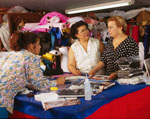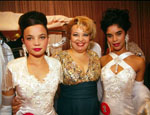Arturo and Elsa Mantilla
Two cases drawn from the 21st Avenue area illuminate the contemporary condition of work and work opportunities in Paterson. Arturo and Elsa Mantilla gradually built a retail clothing and sundries business, eventually opening a store at 368 21st Avenue which they still operate. They were successful because they tapped the Hispanic market at a time — the 1970s — when no other merchants were seriously serving the city's relatively large and growing Hispanic population. Arturo Mantilla told me that when he first arrived in Paterson, in 1970, there were no Spanish-speaking merchants (or employees in the larger shops and stores) in the downtown area. Arturo began selling merchandise from a suitcase, then from his apartment. Eventually, with some luck and a contract with a large New York manufacturer, he and his wife were able to open their first store.
Their business progressed until a period several years ago when it experienced a decline that Arturo attributed to unemployment or under- employment among his client base. So about five years ago, realizing that the retail business might be slow for some time, Arturo and Elsa decided (as Arturo recalls) to "go into manufacturing." They converted their store's third-floor space into a production area, hired sewing-machine operators, and started a custom dressmaking business.
That business has grown, and Arturo and Elsa believe that it will be successful in the long run. Arturo explained that just as they had been the first in Paterson to meet the retail needs of the local Spanish-speakingcommunity, so now they are the first to meet this community's needs in the party-dress and party-planning market.2 Today Elsa and Arturo still appear to be the major players in the dressmaking business. They employ as many as five people and are very busy in the warmer months, when most weddings are planned and when there are special events such as the Dominican Day Parade and the fashion show held in conjunction with it.
The dressmaking and party-planning activity at Elsa's seem to be related to the maintenance of cultural identity among certain segments of the Spanish-speaking community. Elsa told me that however "Americanized" a Hispanic family might be, its members always return to their cultural roots when, for example, they plan a family wedding. And of course, making dresses for events associated with Dominican Day in Paterson — (the parade, the fashion show and dress competition, or the banquet — may be part of a return to, or reproduction and celebration of, the home culture.
It isn't possible to say whether Elsa's turn from selling general commodities (though with an Hispanic emphasis) to selling commodified culture represents the same kind of transformation such changes seem to have marked in the Italian community on the avenue. As noted, the trend in the Italian community may represent a reduction rather than an expansion of cultural activity and identity. The context in which Hispanic culture unfolds in the city may, however, guard against a similar result in the Spanish-speaking community.
2. To my knowledge, only one other shop of this nature exists in the city — Grini's, on Main Street (also owned and operated by a Dominican woman). (Return to Text)

![]()
![]() Exterior of front of Elsa's Wholesale & Retail, 368 21st Avenue.
Exterior of front of Elsa's Wholesale & Retail, 368 21st Avenue.

![]()
![]() Proprietor Elsa Mantilla (in dotted dress) with seamstresses Aurora Goicoechea (in long-sleeve blouse) and Milagros "Millie" Cueto.
Proprietor Elsa Mantilla (in dotted dress) with seamstresses Aurora Goicoechea (in long-sleeve blouse) and Milagros "Millie" Cueto.

![]()
![]() Dressmaker Elsa Mantilla (center) posing with contestants wearing gowns made in her shop.
Dressmaker Elsa Mantilla (center) posing with contestants wearing gowns made in her shop.
Listen
![]() Arturo Mantilla: "I was the second Spanish-speaking business in this area."
Arturo Mantilla: "I was the second Spanish-speaking business in this area."
![]()
![]() (4472291 bytes)
(4472291 bytes)